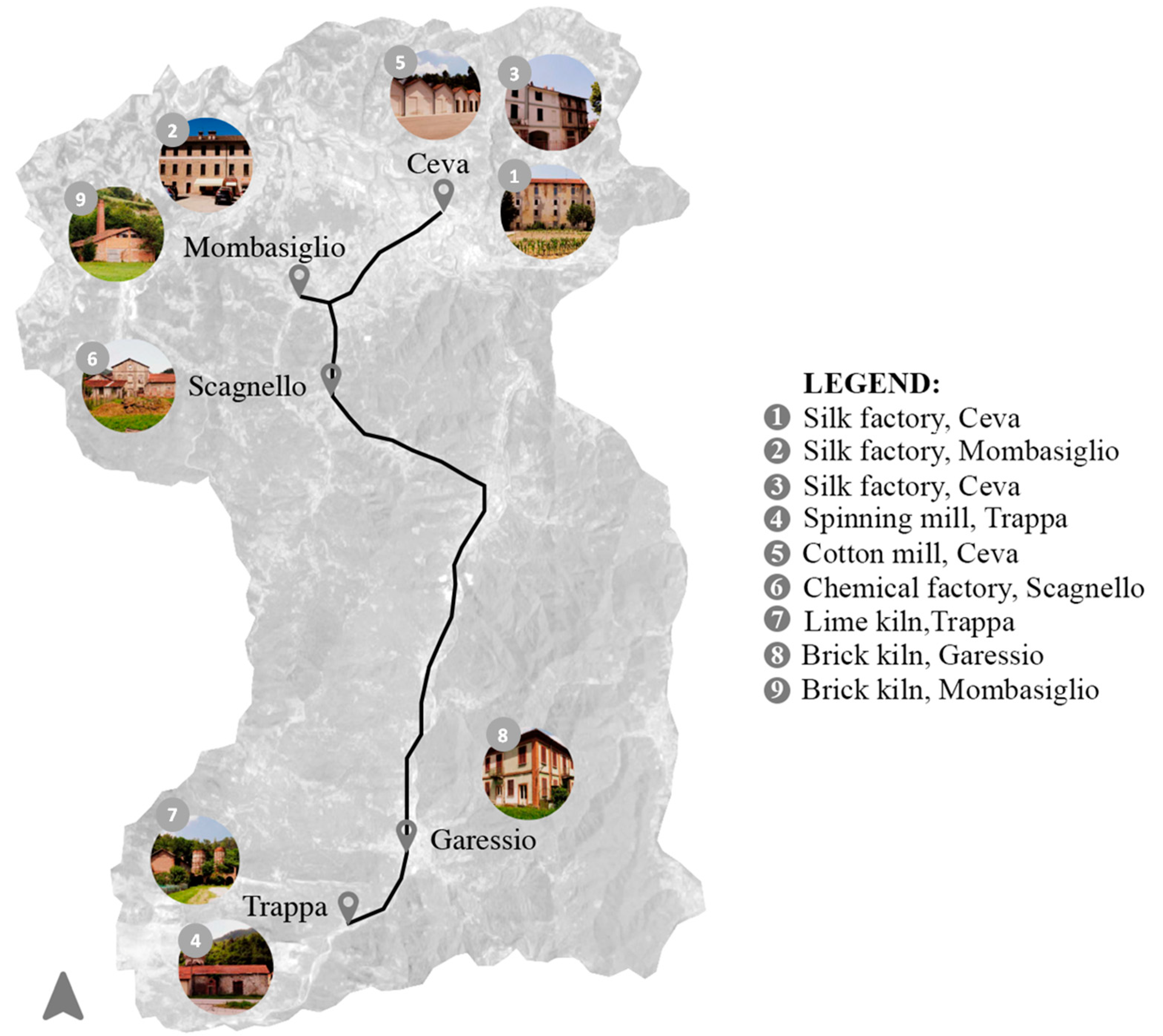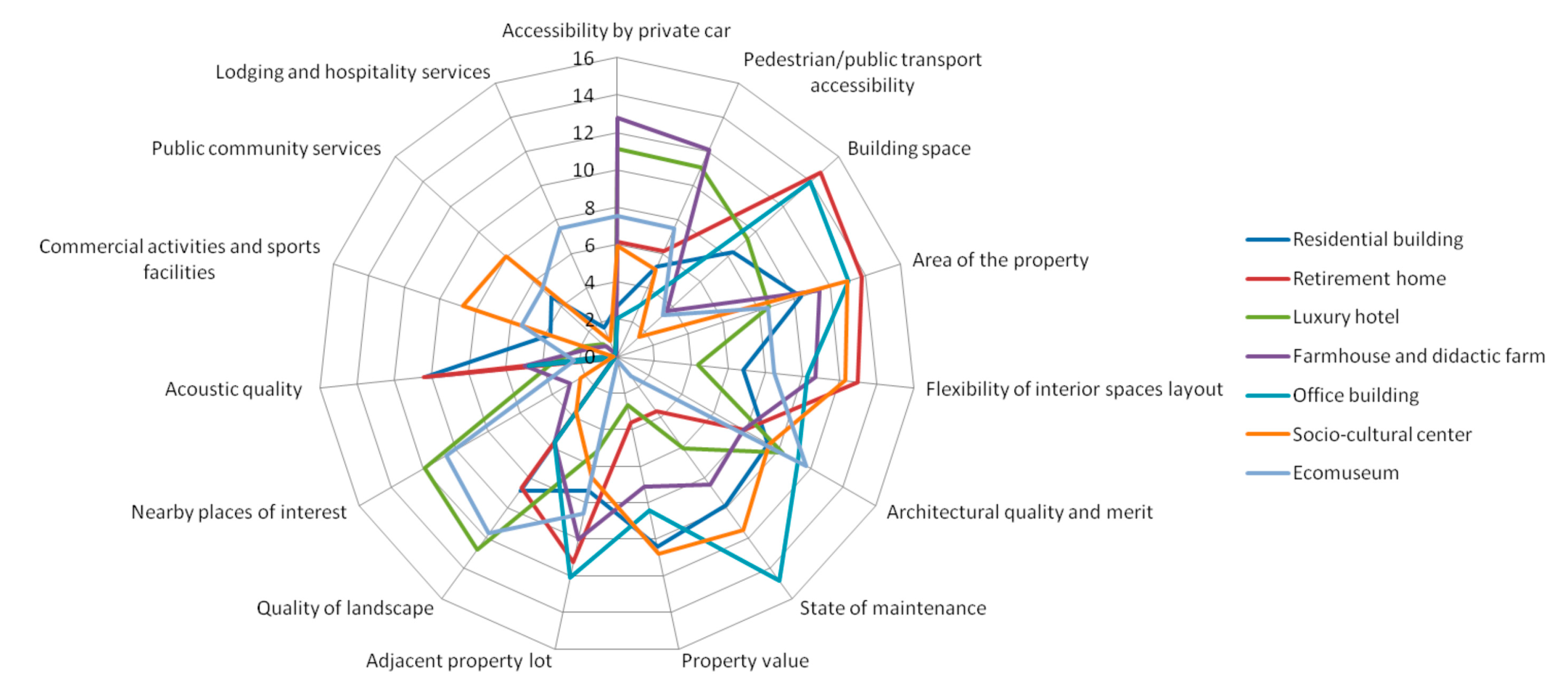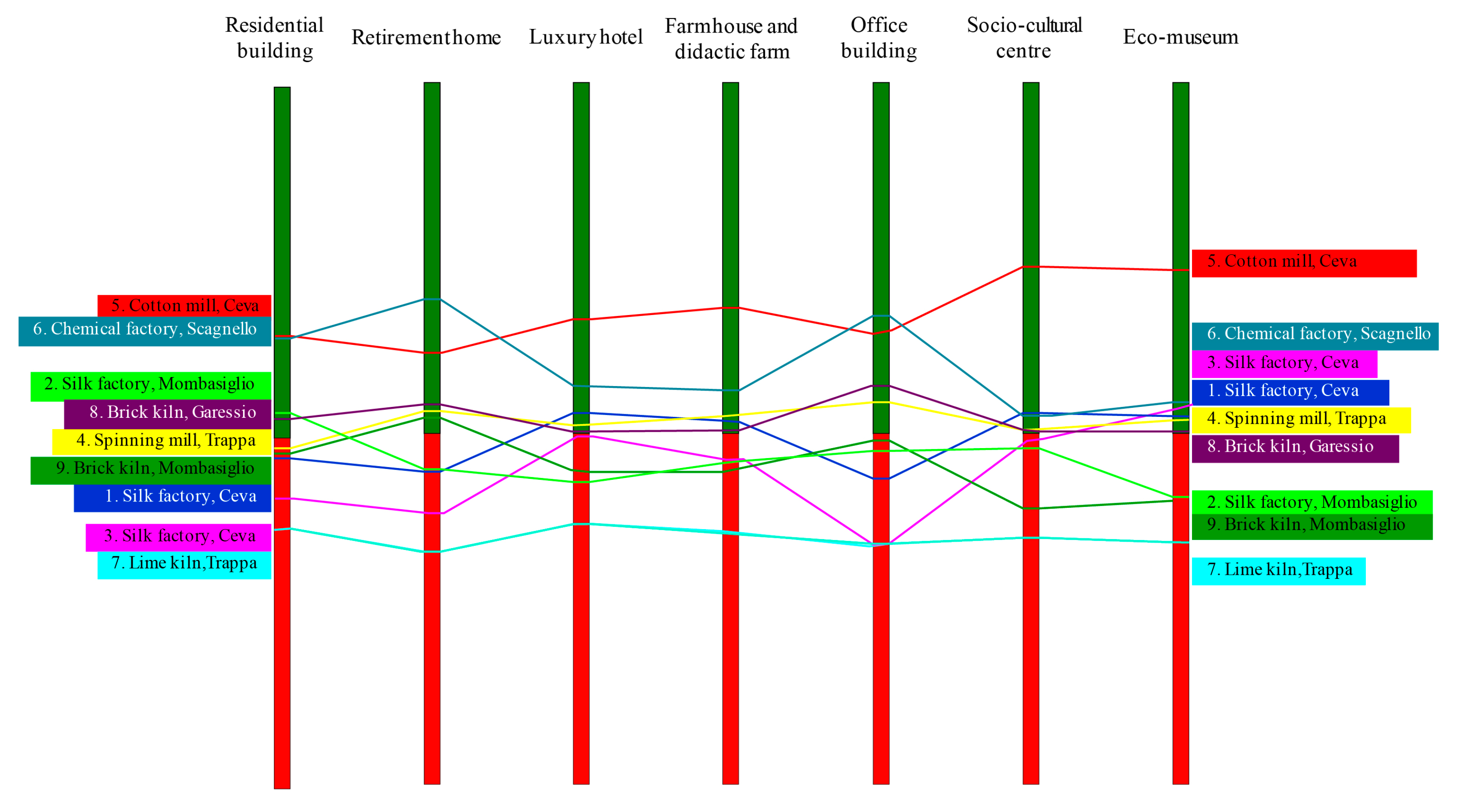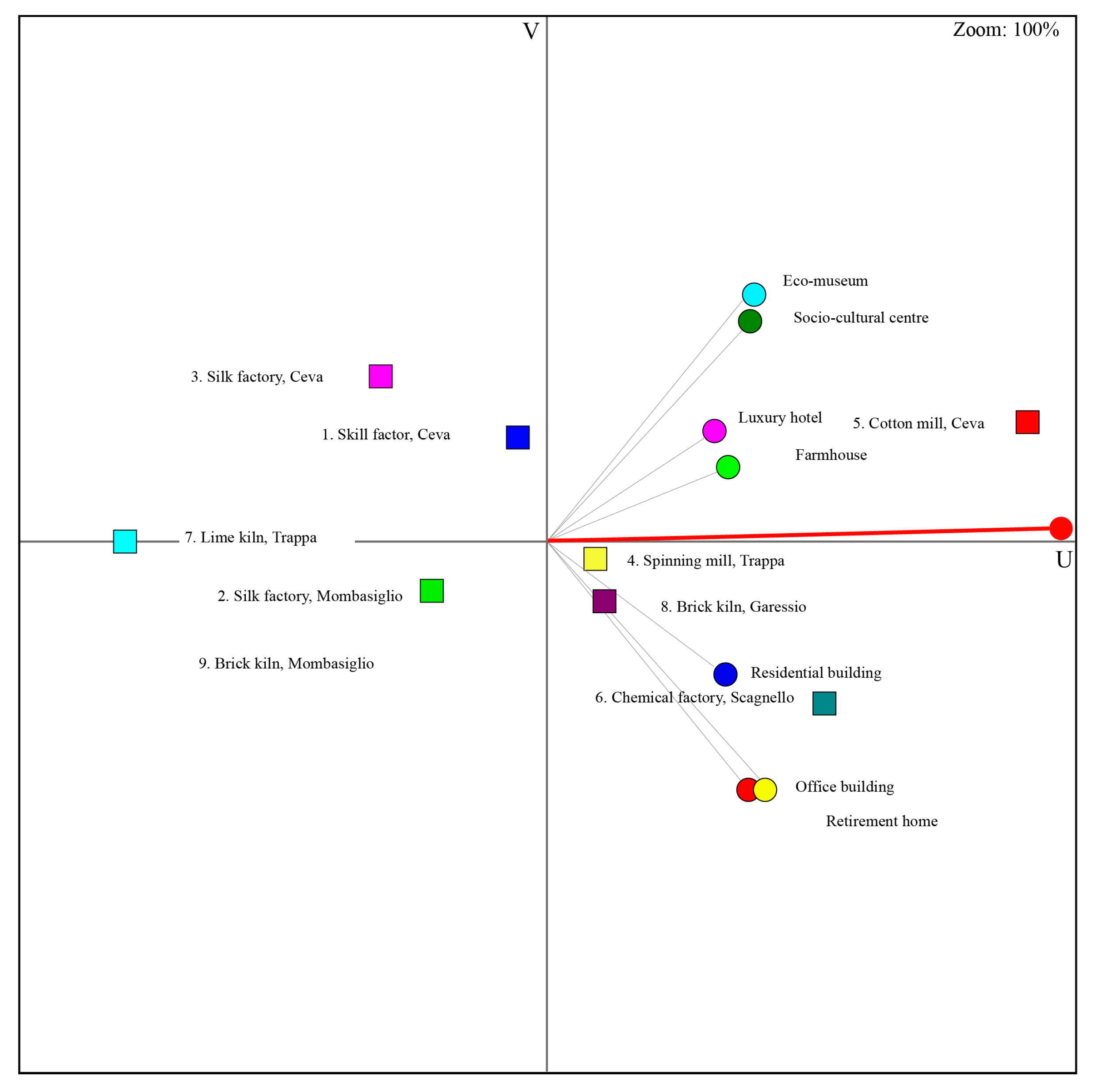Ranking of Adaptive Reuse Strategies for Abandoned Industrial Heritage in Vulnerable Contexts: A Multiple Criteria Decision Aiding Approach
Abstract
:1. Introduction
2. Methodological Background
3. Application
3.1. Description of the Case Study and Presentation of the Alternatives
- the buildings still constitute important representative elements for the identity of the local population;
- the historical productive function can be easily recognized in the buildings;
- the buildings are not occupied, thus allowing the introduction of new functions and destinations.
3.2. PROMETHEE Method Implementation
- (a)
- accessibility by private car (distance in kilometers from the highway “Strada statale 28”);
- (b)
- pedestrian accessibility or accessibility by public transport (walking distance in minutes from Ceva railway station);
- (c)
- availability of the whole building space (dummy 1–0, “yes” or “no” respectively);
- (d)
- available area of the property (gross floor area in square meters);
- (e)
- flexibility of interior spaces layout (potential to host alternative uses expressed on a qualitative measurement scale from 1 to 5, where 5 denotes maximum flexibility and 1 denotes minimum or null flexibility);
- (f)
- architectural quality and merit (building artistic and historic value, expressed on a qualitative measurement scale from 1 to 5, where 5 denotes maximum merit and value whereas 1 denotes minimum or null merit and value);
- (g)
- state of maintenance (maintenance conditions expressed according to a qualitative measurement scale from 1 to 5, where 5 denotes optimum conditions and 1 denotes severe abandonment and/or collapse of structural elements);
- (h)
- property value (assumed to be equal to the property cadastral value in Euros);
- (i)
- appurtenance area of the property (empty portion in square meters of land behind and adjoining house);
- (j)
- quality of landscape and natural and built environment features (pristine condition of landscape and the environment expressed on a qualitative measurement scale from 1 to 5, where 5 denotes excellent conditions and 1 denotes very poor conditions);
- (k)
- presence of nearby places of (historical, artistic, architectural, touristic) interest (number of places of interests within 1 kilometer);
- (l)
- acoustic quality in property surrounding environment (distance in meters by noise sources);
- (m)
- presence of nearby commercial activities (number of shops, stores, markets, supermarkets, etc., within 500 meters or walking distance) and sports facilities (number of facilities within 500 meters or walking distance);
- (n)
- presence of nearby public community services and/or municipal services (number of banks, medical clinics, post offices; within 500 meters or walking distance);
- (o)
- presence of nearby lodging and hospitality services (number of bars, restaurants, hotels, etc. within 500 meters or walking distance).
4. Results and Discussion
5. Conclusions
Author Contributions
Funding
Acknowledgments
Conflicts of Interest
Appendix A
| Criteria | |||||||||||||||
|---|---|---|---|---|---|---|---|---|---|---|---|---|---|---|---|
| Accessibility by Private Car | Pedestrian Accessibility or Accessibility by Public Transport | Building Space | Area of the Property | Flexibility of Interior Spaces Layout | Architectural Quality and Merit | State of Maintenance | Property Value | Appurtenance Area | Quality of Landscape | Nearby Places of Interest | Acoustic Quality | Nearby Commercial Activities/Facilities and Sports Facilities | Public Community Services | Lodging and Hospitality Services | |
| Unit | km | minutes | 0/1 | m2 | 1–5 | 1–5 | 1–5 | € | m2 | 1–5 | No. | km | No | No | No |
| Min/Max | min | min | max | max | max | max | max | min | max | max | max | max | max | max | max |
| Preference function | linear | linear | usual | linear | U-shape | U-shape | U-shape | linear | linear | U-shape | linear | linear | linear | linear | linear |
| (q) | 1 | 10 | - | 50 | 1 | 1 | 1 | 10,000 | 200 | 1 | 2 | 0.1 | 1 | 1 | 1 |
| (p) | 5 | 5 | - | 100 | - | - | - | 50,000 | 500 | - | 5 | 1 | 5 | 3 | 5 |
| 1. Silk factory, Ceva | 0.50 | 13 | 0 | 565 | 3 | 2 | 3 | 115,423 | 1000 | 3 | 8 | 0.26 | 9 | 7 | 3 |
| 2. Silk factory, Mombasiglio | 6.60 | 16 | 0 | 380 | 3 | 2 | 4 | 13,421 | 1000 | 4 | 2 | 4.13 | 1 | 6 | 3 |
| 3. Silk factory, Ceva | 0.05 | 3 | 0 | 510 | 2 | 3 | 2 | 199,826 | 100 | 2 | 10 | 0.02 | 17 | 78 | 11 |
| 4. Spinning mill, Trappa | 0.00 | 33 | 0 | 5255 | 3 | 5 | 3 | 645,172 | 5400 | 4 | 0 | 0.01 | 0 | 0 | 2 |
| 5. Cotton mill, Ceva | 1.00 | 11 | 0 | 1850 | 4 | 4 | 5 | 177,655 | 6300 | 3 | 10 | 0.51 | 22 | 21 | 10 |
| 6. Chemical factory, Cagnello | 10.70 | 21 | 1 | 1675 | 4 | 4 | 1 | 52,069 | 6700 | 5 | 3 | 6.3 | 0 | 0 | 0 |
| 7. Lime kiln, Trappa | 0.06 | 38 | 0 | 335 | 1 | 3 | 1 | 20,403 | 1200 | 4 | 0 | 0.08 | 0 | 1 | 1 |
| 8. Brick kiln, Garessio | 0.55 | 36 | 1 | 300 | 2 | 4 | 3 | 128,846 | 11,700 | 3 | 1 | 0.44 | 8 | 3 | 3 |
| 9. Brick kiln, Mombasiglio | 5.30 | 16 | 1 | 170 | 5 | 2 | 2 | 0 | 1500 | 4 | 0 | 2.93 | 0 | 3 | 0 |
References
- Fusco Girard, L.; Gravagnuolo, A. Circular economy and cultural heritage/landscape regeneration. Circular business, financing and governance models for a competitive Europe. BDC Bollettino Del Centro Calza Bini 2017, 17, 35–52. [Google Scholar]
- Latham, D. Creative Re-Use of Buildings; Donhead Publishing: Shaftesbury, UK, 2000; Volume II. [Google Scholar]
- Wilkinson, S.J.; Reed, R.; James, K. Using building adaptation to deliver sustainability in Australia. Struct. Surv. 2009, 27, 46–61. [Google Scholar] [CrossRef] [Green Version]
- Cooper, I. Post-occupancy evaluation-where are you? Build. Res. Inf. 2001, 29, 158–163. [Google Scholar] [CrossRef]
- Bullen, P.A.; Love, E. Adaptive reuse of heritage buildings. Struct. Surv. 2011, 29, 411–421. [Google Scholar] [CrossRef]
- Ball, R. Developers, regeneration and sustainability issues in the reuse of vacant buildings. Build. Res. Inf. 1999, 27, 140–148. [Google Scholar] [CrossRef]
- Plevoets, B.; Van Cleempoel, K. Adaptive reuse as a strategy towards conservation of cul-tural heritage: A literature review. WIT Trans. Built Environ. 2011, 118, 155–164. [Google Scholar]
- Scarrocchia, S. Alois Riegl. Teoria e Prassi Della Conservazione dei Monumenti. Antologia di Scritti, Discorsi, Rapporti, 1898–1905; Clueb: Bologna, Italy, 1995. [Google Scholar]
- Forte, C. Valore di Scambio e Valore D’uso Sociale dei Beni Culturali Immobiliari; Arte Tipografica: Napoli, Italy, 1977. [Google Scholar]
- Fusco Girard, L. Risorse Architettoniche e Culturali: Valutazione e Strategie di Conservazione; FrancoAngeli: Milano, Italy, 1987. [Google Scholar]
- Pearce, D.W.; Turner, R.K. Economics of Natural Resources and the Environment; Johns Hopkins University Press: Baltimore, MD, USA, 1990. [Google Scholar]
- European Commission. Towards an Integrated Approach to Cultural Heritage for Europe. 2014. Available online: http://ec.europa.eu/culture/library/publications/2014-heritage-communication_en.pdf (accessed on 28 December 2018).
- Avrami, E.; Mason, M.R.; De La Torre, M. Values and Heritage Conservation: Research Report; The Getty Conservation Institute: Los Angeles, CA, USA, 2000. [Google Scholar]
- Klamer, A. The values of cultural heritage. In Handbook on the Economics of Cultural Heritage; Rizzo, I., Mignosa, A., Eds.; Edward Elgar: Cheltenham, UK, 2013. [Google Scholar]
- Elsorady, D. The economic value of heritage properties in Alexandria, Egypt. J. Cult. Herit. 2014, 15, 511–521. [Google Scholar] [CrossRef]
- Mısırlısoy, D.; Gunçe, K. Adaptive reuse strategies for heritage buildings: A holistic approach. Sustain. Cities Soc. 2016, 26, 91–98. [Google Scholar] [CrossRef]
- Oppio, A.; Bottero, M. Conflicting values in designing adaptive reuse for cultural heritage. A case study of social multicriteria evaluation. Lect. Notes Comput. Sci. 2017, 10406, 607–623. [Google Scholar]
- Oppio, A.; Bottero, M.; Ferretti, V. Designing adaptive reuse strategies for cultural heritage with choice experiments. Green Energy Technol. 2017, 303–315. [Google Scholar] [CrossRef]
- Munda, G. Multicriteria Evaluation in a Fuzzy Environment. Theory and Applications in Ecological Economics; Physica-Verlag: Heidelberg, Germany, 1995. [Google Scholar]
- Munda, G. Social multi-criteria evaluation (SMCE): Methodological foundations and operational consequences. Eur. J. Oper. Res. 2004, 158, 662–677. [Google Scholar] [CrossRef]
- Damart, S.; Roy, B. The uses of cost benefit analysis in public transportation decision-making in France. Transp. Policy 2009, 16, 200–212. [Google Scholar] [CrossRef]
- Bottero, M. L’Analisi Multicriteri. Intervista a Bernard Roy. Valori Valutazioni 2014, 12, 7–24. [Google Scholar]
- Corrente, S.; Figueira, J.R.; Greco, S. The SMAA-PROMETHEE method. Eur. J. Oper. Res. 2014, 239, 514–522. [Google Scholar] [CrossRef] [Green Version]
- Bottero, M.; D’Alpaos, C.; Oppio, A. Multicriteria evaluation of urban regeneration processes: An application of PROMETHEE method in northern Italy. Adv. Oper. Res. 2018, 9276075, 1–12. [Google Scholar] [CrossRef]
- Brans, J.P. L’ingénierie de la décision; Elaboration d’instruments d’aide à la décision. La méthode PROMETHEE. In L’aide à la décision: Nature, Instruments et Perspectives d’Avenir; Nadeau, R., Landry, M., Eds.; Presses de l’Université Laval: Québec, Canada, 1982; pp. 183–213. [Google Scholar]
- Brans, J.; Vincke, P. A preference ranking organization method (The PROMETHEE method for multiple criteria decision making). Manag. Sci. 1985, 31, 647–656. [Google Scholar] [CrossRef]
- Brans, J.P.; Vincke, P.; Mareschal, B. How to select and how to rank projects: The PROMETHEE method. Eur. J. Oper. Res. 1986, 24, 228–238. [Google Scholar] [CrossRef]
- Brans, J.P.; Mareschal, B. PROMETHEE V—MCDM problems with segmentation constraints. INFOR Inf. Syst. Oper. Res. 1992, 30, 85–96. [Google Scholar] [CrossRef]
- Brans, J.P.; Mareschal, B. The PROMETHEE VI procedure. How to differentiate hard from soft multicriteria problems. J. Decis. Syst. 1995, 4, 213–223. [Google Scholar]
- Greco, S.; Kadzinski, M.; Mousseau, V.; Słowinski, R. ELECTREGKMS: Robust ordinal regression for outranking methods. Eur. J. Oper. Res. 2011, 214, 118–135. [Google Scholar] [CrossRef]
- Kadzinski, M.; Greco, S.; Słowinski, R. Extreme ranking analysis in robust ordinal regression. Omega 2012, 40, 488–501. [Google Scholar] [CrossRef]
- Brans, J.P.; De Smet, Y. PROMETHEE methods. Int. Ser. Oper. Res. Manag. Sci. 2016, 233, 187–219. [Google Scholar]
- Roy, B.; Bouyssou, D. Aide Multicritere a la Decision: Methodes et Cas; Economica: Paris, France, 1993. [Google Scholar]
- Brans, J.P.; Mareschal, B. PROMETHEE methods. In Multiple Criteria Decision Analysis: State of the Art Surveys; Figueira, J., Greco, S., Ehrgott, M., Eds.; Springer: Boston, MA, USA, 2005; pp. 163–196. [Google Scholar]
- Brans, J.P.; Mareschal, B.; Vincke, P. PROMETHEE: A new family of outranking methods in multi-criteria analysis. In Operational Research ‘84; Brans, J.P., Ed.; North-Holland: Amsterdam, The Netherlands, 1984; pp. 477–490. [Google Scholar]
- Behzadian, M.; Kazemzadeh, R.B.; Albadvi, A.; Aghdasi, M. PROMETHEE: A comprehensive literature review on methodologies and applications. Eur. J. Oper. Res. 2010, 200, 198–215. [Google Scholar] [CrossRef]
- Arcidiacono, S.G.; Corrente, S.; Greco, S. GAIA-SMAA-PROMETHEE for a hierarchy of interacting criteria. Eur. J. Oper. Res. 2018, 270, 606–624. [Google Scholar] [CrossRef]
- Govindan, K.; Kadzinski, M.; Sivakumar, R. Application of a novel PROMETHEE-based method for construction of a group compromise ranking to prioritization of green suppliers in food supply chain. Omega 2017, 71, 129–145. [Google Scholar] [CrossRef]
- Bagherikahvarin, M.; DeSmet, Y. Determining new possible weight values in PROMETHEE: A procedure based on data envelopment analysis. J. Oper. Res. Soc. 2017, 68, 484–495. [Google Scholar] [CrossRef]
- Bagherikahvarin, M.; De Smet, Y. A ranking method based on DEA and PROMETHEE II (a rank based on DEA & PR.II). Measurement 2016, 89, 333–340. [Google Scholar]
- Kilic, H.; Zaim, S.; Delen, D. Selecting “The Best” ERP system for SMEs using a combination of ANP and PROMETHEE methods. Expert Syst. Appl. 2015, 42, 2343–2352. [Google Scholar] [CrossRef]
- Chen, Y.H.; Wang, T.C.; Wu, C.Y. Strategic decisions using the fuzzy PROMETHEE for IS outsourcing. Expert Syst. Appl. 2011, 38, 13216–13222. [Google Scholar] [CrossRef]
- Taha, Z.; Rostam, S. A hybrid fuzzy AHP-PROMETHEE decision support system for machine tool selection in flexible manufacturing cell. J. Intell. Manuf. 2012, 23, 2137–2149. [Google Scholar] [CrossRef]
- Doan, N.A.V.; De Smet, Y. An alternative weight sensitivity analysis for PROMETHEE II rankings. Omega 2018, 80, 166–174. [Google Scholar] [CrossRef]
- Kadzinski, M.; Ciomek, K. Integrated framework for preference modeling and robustness analysis for outranking-based multiple criteria sorting with ELECTRE and PROMETHEE. Inf. Sci. 2016, 352, 167–187. [Google Scholar] [CrossRef]
- Lopes, A.P.F.; Muñoz, M.M.; Alarcón-Urbistondo, P. Regional tourism competitiveness using the PROMETHEE approach. Ann. Tour. Res. 2018, 73, 1–13. [Google Scholar] [CrossRef]
- Butowski, L. An integrated AHP and PROMETHEE approach to the evaluation of the attractiveness of European maritime areas for sailing tourism. Morav. Geogr. Rep. 2018, 26, 135–148. [Google Scholar] [CrossRef]
- Roozbahani, A.; Zahraie, B.; Tabesh, M. PROMETHEE with Precedence Order in the Criteria (PPOC) as a New Group Decision Making Aid: An Application in Urban Water Supply Management. Water Resour. Manag. 2012, 26, 3581–3599. [Google Scholar] [CrossRef]
- Christian, A.V.; Zhang, Y.; Salifou, C. Application of PROMETHEE-GAIA Method in the Entry Mode Selection Process in International Market Expansion. Open J. Bus. Manag. 2016, 4, 238–250. [Google Scholar] [CrossRef]
- Veličkovska, I.; Maja Stanujkić, M. The Use of AHP-PROMETHEE Method in Environmental Management-National Park Djerdap. Eng. Manag. 2018, 4, 65–77. [Google Scholar]
- Mavrotas, G.; Ziomas, I.C.; Diakouaki, D. A Combined MOIP–MCDA Approach to Building and Screening Atmospheric Pollution Control Strategies in Urban Regions. Environ. Manag. 2006, 38, 149–160. [Google Scholar] [CrossRef]
- Juan, Y.-K.; Roper, K.O.; Castro-Lacouture, D.; Kim, J.H. Optimal decision making on urban renewal projects. Manag. Decis. 2010, 48, 207–224. [Google Scholar] [CrossRef]
- Bottero, M.; Baudino, I.; Antonelli, P. Strategic assessment and multicriteria analysis: An application of the PROMETHEE method for the analysis of urban regeneration scenarios. Geoingegneria Ambientale Mineraria 2016, 148, 5–16. [Google Scholar]
- Dirutigliano, D.; Delmastro, C.; Torabi Moghadam, S. Energy efficient urban districts: A multi-criteria application for selecting retrofit actions. Int. J. Heat Technol. 2017, 35, S49–S57. [Google Scholar] [CrossRef]
- Wagner, M. A Research Proposal on the Parametric City Governance. In Smart and Sustainable Planning for Cities and Regions-Results of SSPCR 2015; Bisello, A., Vettorato, D., Stephens, R., Elisei, P., Eds.; Green and Energy Technology; Springer: Berlin, Germany, 2017; pp. 205–219. [Google Scholar]
- Fusco Girard, L.; De Toro, P. Integrated spatial assessment: A multicriteria approach to sustainable development of cultural and environmental heritage in San Marco dei Cavoti, Italy. Cent. Eur. J. Oper. Res. 2007, 15, 281–299. [Google Scholar] [CrossRef]
- Oppio, A.; Bottero, M.; Ferretti, V.; Fratesi, U.; Ponzini, D.; Pracchi, V. Giving space to multicriteria analysis for complex cultural heritage systems: The case of the castles in Valle D’Aosta Region, Italy. J. Cult. Herit. 2015, 16, 779–789. [Google Scholar] [CrossRef]
- Ferretti, V.; Comino, E. An integrated framework to assess complex cultural and natural heritage systems with MultiAttribute Value Theory. J. Cult. Herit. 2015, 16, 688–697. [Google Scholar] [CrossRef]
- Morkunaite, Z.; Podvezko, V.; Kutut, V. Selection Criteria For Evaluating Contractors Of Cultural Heritage Objects. Procedia Eng. 2017, 208, 90–97. [Google Scholar] [CrossRef]
- Nesticò, A.; Morano, P.; Sica, F. A model to support the public administration decisions for the investments selection on historic buildings. J. Cult. Herit. 2018, 33, 201–207. [Google Scholar] [CrossRef]
- Seddiki, M.; Anouche, K.; Bennadji, A. An integrated Delphi-FAHP-PROMETHEE for the thermal renovation of masonry buildings in Algeria. In Proceedings of the 5th International Conference on Heritage and Sustainable Development (Heritage 2016); Amoeda, R., Lira, S., Pinheiro, C., Eds.; Green Line Institute: Barcelos, Portugal, 2016; pp. 171–180. [Google Scholar]
- Bottero, M.; Dell’Anna, F.; Nappo, M. Evaluating tangible and intangible aspects of cultural heritage: An application of the promethee method for the reuse project of the Ceva-Ormea railway. Green Energy Technol. 2018, 285–295. [Google Scholar] [CrossRef]
- Perlo, F. Il patrimonio industriale in Alta Val Tanaro, Valle Mongia e Cebano: Conoscenza, catalogazione e valutazione multicriteriale di scenario di riuso dei siti dismessi, Specailization thesis, Architectural and Landscape Heritage post-graduated specialization school, Polytechnic University of Turin (supervisiors: Laura Guardamagna and Marta Bottero). 2016. Available online: http://www.scuolabap.polito.it/content/download/437/1904/version/1/file/TESI+2015-2017.pdf (accessed on 2 July 2018).
- Roy, B. Multicriteria Methodology for Decision Aiding; Kluwer Academic: Dordrecht, The Netherlands, 1996. [Google Scholar]
- Dias, L.C.; Antunes, C.H.; Dantas, G.; de Castro, N.; Zamboni, L. A multi-criteria approach to sort and rank policies based on Delphi qualitative assessments and ELECTRE TRI: The case of smart grids in Brazil. Omega 2018, 76, 100–111. [Google Scholar] [CrossRef]
- D’Alpaos, C.; Bragolusi, P. Multicriteria Prioritization of Policy Instruments in Buildings Energy Retrofit. Valori Valutazioni 2018, 21, 15–26. [Google Scholar]
- Simos, J. L’evaluation Environnementale: Un Processus Cognitif Neegociee. Ph.D. Thesis, DGF-EPFL, Lausanne, Switzerland, 1990. [Google Scholar]
- Simos, J. Evaluer L’impact sur L’environnement: Une Approche originale par L’analyse Multicritère et la Négociation; Presses Polytechniques et Universitaires Romandes: Lausanne, Switzerland, 1990. [Google Scholar]
- Figueira, J.; Roy, B. Determining the weights of criteria in the ELECTRE type methods with a revised Simos’ procedure. Eur. J. Oper. Res. 2002, 139, 317–326. [Google Scholar] [CrossRef]
- Siskos, E.; Tsotsolas, N. Elicitation of criteria importance weights through the Simos method: A robustness concern. Eur. J. Oper. Res. 2015, 246, 543–553. [Google Scholar] [CrossRef]
- Canesi, R.; D’Alpaos, C.; Marella, M. Forced sale values vs. Market values in Italy. J. Real Estate Lit. 2016, 24, 377–401. [Google Scholar]
- Canesi, R.; D’Alpaos, C.; Marella, G. Foreclosed homes market in Italy: Bases of value. Int. J. Hous. Sci. Appl. 2016, 40, 201–209. [Google Scholar]
- Bertolini, M.; D’Alpaos, C.; Moretto, M. Do Smart Grids boost investments in domestic PV plants? Evidence from the Italian electricity market. Energy 2018, 149, 890–902. [Google Scholar] [CrossRef]
- Dolores, L.; Macchiaroli, M.; De Mare, G. Sponsorship for the sustainability of historical-architectural heritage: Application of a model’s original test finalized to maximize the profitability of private investors. Sustainability 2017, 9, 1750. [Google Scholar] [CrossRef]
- Augusto, M.; Lisboa, J.; Yasin, M.; Figueira, J.R. Benchmarking in a multiple criteria performance context: An application and a conceptual framework. Eur. J. Oper. Res. 2008, 184, 244–254. [Google Scholar] [CrossRef] [Green Version]
- Berta, M.; Bottero, M.; Ferretti, V. A mixed methods approach for the integration of urban design and economic evaluation: Industrial heritage and urban regeneration in China. Environ. Plan. B Urban Anal. City Sci. 2018, 45, 208–232. [Google Scholar] [CrossRef]
- Del Giudice, V.D.; De Paola, P.; Torrieri, F. An integrated choice model for the evaluation of urban sustainable renewal scenarios. Adv. Mater. Res. 2014, 1030, 2399–2406. [Google Scholar] [CrossRef]
- Oppio, A.; Bottero, M. A strategic management based on multicriteria decision analysis: An application for the Alpine regions. Int. J. Multicrit. Decis. Mak. 2018, 7, 236–262. [Google Scholar] [CrossRef]
- Ortiz, M.S.O.; Geneletti, D. Assessing mismatches in the provision of urban ecosystem services to support spatial planning: A case study on recreation and food supply in Havana, Cuba. Sustainability 2018, 10. [Google Scholar] [CrossRef]





| Criteria | Decision Scenarios | ||||||
|---|---|---|---|---|---|---|---|
| Residential Building | Retirement Home | Luxury Hotel | Farmhouse and Didactic farm | Office Building | Socio-Cultural Center | Ecomuseum | |
| Accessibility by private car | 2.71 | 6.16 | 11.09 | 12.8 | 2.02 | 5.9 | 7.5 |
| Pedestrian or public transport accessibility | 5.27 | 6.16 | 11.09 | 12.1 | 2.94 | 5.1 | 7.5 |
| Building space | 8.34 | 14.69 | 9.41 | 3.6 | 13.94 | 1.6 | 3.3 |
| Area of the property | 10.38 | 13.83 | 8.58 | 11.4 | 13.02 | 13 | 8.5 |
| Flexibility of interior spaces layout | 6.8 | 12.98 | 4.36 | 10.7 | 10.27 | 12.3 | 8.5 |
| Architectural quality and merit | 9.36 | 7.86 | 10.26 | 7.8 | 11.19 | 9.4 | 11.7 |
| State of maintenance | 9.87 | 3.6 | 6.05 | 8.5 | 14.85 | 11.5 | 1.3 |
| Property value | 10.39 | 3.6 | 2.68 | 7.1 | 8.44 | 10.8 | 0.2 |
| Appurtenance area | 7.32 | 11.27 | 5.21 | 10 | 12.11 | 6.6 | 8.6 |
| Quality of landscape | 8.85 | 8.71 | 12.78 | 5.7 | 5.69 | 3.7 | 11.7 |
| Nearby places of interest | 0.15 | 0.18 | 11.93 | 2.9 | 0.19 | 2.3 | 10.6 |
| Acoustic quality | 10.39 | 10.42 | 3.53 | 5 | 4.77 | 0.2 | 2.3 |
| Nearby commercial activities/facilities and sports facilities | 3.73 | 0.18 | 1.85 | 1.5 | 0.19 | 8.7 | 5.4 |
| Public community services | 4.76 | 0.18 | 1.01 | 0.8 | 0.19 | 8 | 5.4 |
| Lodging and hospitality services | 1.68 | 0.18 | 0.17 | 0.1 | 0.19 | 0.9 | 7.5 |
© 2019 by the authors. Licensee MDPI, Basel, Switzerland. This article is an open access article distributed under the terms and conditions of the Creative Commons Attribution (CC BY) license (http://creativecommons.org/licenses/by/4.0/).
Share and Cite
Bottero, M.; D’Alpaos, C.; Oppio, A. Ranking of Adaptive Reuse Strategies for Abandoned Industrial Heritage in Vulnerable Contexts: A Multiple Criteria Decision Aiding Approach. Sustainability 2019, 11, 785. https://doi.org/10.3390/su11030785
Bottero M, D’Alpaos C, Oppio A. Ranking of Adaptive Reuse Strategies for Abandoned Industrial Heritage in Vulnerable Contexts: A Multiple Criteria Decision Aiding Approach. Sustainability. 2019; 11(3):785. https://doi.org/10.3390/su11030785
Chicago/Turabian StyleBottero, Marta, Chiara D’Alpaos, and Alessandra Oppio. 2019. "Ranking of Adaptive Reuse Strategies for Abandoned Industrial Heritage in Vulnerable Contexts: A Multiple Criteria Decision Aiding Approach" Sustainability 11, no. 3: 785. https://doi.org/10.3390/su11030785
APA StyleBottero, M., D’Alpaos, C., & Oppio, A. (2019). Ranking of Adaptive Reuse Strategies for Abandoned Industrial Heritage in Vulnerable Contexts: A Multiple Criteria Decision Aiding Approach. Sustainability, 11(3), 785. https://doi.org/10.3390/su11030785






